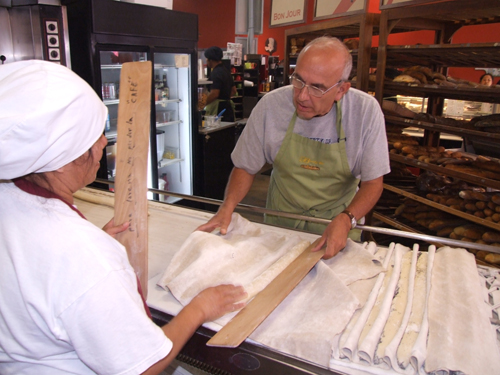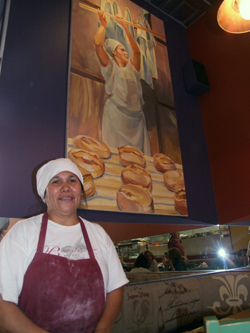
Story and photos by Donald H. Harrison

SAN DIEGO–If breaking bread together is a way to promote peace and friendship, how much more so is baking bread together!
I watched Charles Kaufman, a former movie producer who today is one of San Diego’s chief bakers, and veterinarian Yoni Peres, the first son of Israel’s ‘First Family,’ meet for the first time. Then I took note as their common love for bread-making leavened a new-found friendship.
Kaufman is the founder of Bread and Cie, which since 1993 has operated a cafe in the Hillcrest area of San Diego, and since 2001 a wholesale bakery near Old Town San Diego. A man with a fast wit, he used to direct “B” movies with such titles as The Secret Dreams of Mona Q (1977); Mother’s Day (1980); Ferocious Female Freedom Fighters (1982), When Nature Calls (1985), and Jakarta (1988). He wrote screenplays for other movies and television series and occasionally took a small part “when I couldn’t afford to pay actors.”
Getting independently produced movies into theatres became increasingly difficult, Kaufman said, so he decided to study bread-making and eventually determined that San Diego would be a good city to start up a hard-crust European-style bakery. “We brought in an oven, hit the timing right, got the location right (at 350 University Avenue), and we are pretty much the largest in San Diego. We began making 30 loaves a day, and today on weekends (mainly at the wholesale bakery at 4901 Pacific Highway) we produce between 6,000 and 7,000.”
Peres, a doctor of veterinary medicine and former chief of the teaching hospital at Hebrew University’s Koret School of Veterinary Medicine, today owns an emergency veterinary hospital at Kfar HaYarok, north of Tel Aviv.
Peres told Kaufman that he knows where his love of animals came from: “My parents (Shimon, today the President of Israel, and the late Sonia Peres) came out of a kibbutz (Alumot) and since I was one year old, all my vacations we would go to the kibbutz, with the goats and the sheep and the cows and the donkeys.” But where did his love of bread and his desire to learn from the best how to make it come from? Peres wasn’t sure, but “in the back of my mind, I thought one day I will do it, I would love to do it. But I had no idea how to do it.”
“Me too,” recalled Kaufman. “I loved the smell of bread. I loved the taste of bread. I saw it had commercial possibilities. I had something in my past. My grandma used to bake this fantastic bread. There are a couple of recipes that were hers. Did your mom bake?”
“No,” responded Peres. “She didn’t bake.” Her specialty was chicken — grilled chicken with a honey glaze.”
Kaufman, along with his partner Chris Jurca, on Tuesday, July 3, conducted Peres on a tour of the wholesale bakery where approximately 80 employees keep the23,000-square-foot facility operating 24 hours a day/ 7 days a week. Later he took Peres to the cafe, where Peres put on an apron and learned how Bread and Cie readies bread for its steam oven.
There are essentially four ingredients in making bread, Peres (who sometimes writes for San Diego Jewish World) explained to me. These are flour, water, salt and yeast. Some bakeries buy commercial yeast, but Bread and Cie prefers to cultivate its own yeast by letting flour and water ferment together.
Jurca explained that dough from this “mother” mixture is removed from a small vat and then utilized in a second “starter” mixture for the making of the daily bread. The dough in the mother mixture is augmented with water and flour, so that the concoction, which is kept at a precise temperature, is always being built up and always available. Second-generation mixtures — one for white bread, the other for whole wheat– are built several times each day for the next rounds of bread production.
“What percentage is water?” Peres wanted to know .
“That varies between the doughs,” responded Jurca. The mixture he then was displaying was approximately 65 percent water (by weight) whereas breads with higher water content (and less calories) are about 73 to 75 percent. Breads infused with olives require only about 60 percent water because “if we made it to a normal percentage it would be completely wet,” Jurca explained. When olives are added, “the dough absorbs more moisture.”
“Do you use ice water or chilled water?” asked his Israeli student.
“Chilled water We have a couple of water chillers.”
“Filtered water?”
“Carbon-filtered water. The water of Southern California isn’t so nice.”
Explained Kaufman: “When we began we did reverse-osmosis water, because the water was so bad here.” However the reverse-osmosis process robbed the water of every ingredient that contributed to the taste of the bread. With that water, the bread “didn’t rise,” Kaufman said. “So it needs some of the natural elements in the water.”
The dough is kept in a room with a constant dry temperature of 80 degrees during part of the process, and then to retard the fermentation process, enabling the flavor to deepen, the dough is placed for a period of time in a refrigerated room until being returned to a warmer environment. How long to let the dough ferment before baking it is one of the factors that will influence the bread’s taste.
Much of what Peres was shown paralleled his explorations of major bakeries in other large cities such as Jerusalem and New York City, and he’ll be visiting Paris later this month. However, Jurca, who once had studied mechanical engineering at UC Berkeley, had installed machines at the wholesale bakery that Peres said were new to him. About 40 inches wide and 8 1/2 feet long, these were automatic loaders that scooted effortlessly under assemblages of dough placed on table trays and at a press of a button carried them in and out of the oven. Once the dough is loaded into the oven, steam is injected in a process facilitating the baking.
Kaufman said the automatic loader enables the breads to be transported to the oven and back without being bruised.
Peres drew out his smart phone and took a photo of the automatic loader, and showed Kaufman and Jurca photographs he had taken in the Mea Shearim section of Jerusalem of a 120-year-old gas-oven bakery, which is especially busy on Thursday nights producing challah for Shabbat.
Peres related that on one occasion, he started to teach his 8-year-old daughter, Maya, about how to make challah.
“You teach me?” he quoted the youngster as saying, before showing that she could teach her daddy. She sang a braiding song, “1 on 2, 3 on 4” and “in five seconds she had it braided.”
“We need her to come in and instruct here” said Kaufman. “But we can teach you a six braid so she can have respect for you again.”
Challah apparently is enjoyed as much by people who don’t keep kosher as those who do, because Bread and Cie does not have a hechsher. “What we would have to do here to make it acceptable to the rabbis in this town would be rough,” Kaufman said. It’s not only a question of how the facility is operated but what products are used in the bread’s preparations. For example, said Kaufman, neither the flour nor dairy products used in some of the breads have kosher certification.


Next stop on the tour was the retail operation in the Hillcrest neighborhood, where Kaufman and baker Lorena Velasquez, whose large portrait graces one of the walls of the restaurant, had Peres tie on his apron and learn how get baguettes ready for a lunch-time crowd.
Peres threw himself enthusiastically into the task, removing from protective wrappers dough that had been shaped at the wholesale facility and scoring it with a razor in diagonal patterns. Scoring provides an escape route during the baking process for the gasses produced by fermentation. Kaufman explained that Bread and Cie’s sourdough breads are scored differently from white breads, so sellers can look into the bin and see immediately which is which.
Study has its rewards. Following the baking session, Kaufman and Velasquez put together a plate of bread samples for Peres’ tasting pleasure. There were small pieces of plain bread, sourdough, rye with seeds, and plain rye, breads infused with olives or fennel, brioche and baguettes. And plenty of butter.
“We have an expression that we use out here,” said the irrepressible Kaufman. “A shmeer of butter.”
Peres did not immediately perceive that Kaufman was joking.
“Shmeer ? That’s Yiddish,” he said.
“Really?” deadpanned Kaufman.
Friendships often are built on reciprocity. Peres was quick to invite Kaufman and his wife to visit him and his family in Israel, where they might even go on a bread-tasting spree.
“It would be an interesting thing to have a world bread tour,” mused Kaufman. “There are so many interesting breads around the world. There could be a Middle Eastern bread tour. They have a fantastic selection of breads in different shapes and sizes!”
*
Harrison is editor of San Diego Jewish World. He may be contacted at donald.harrison@sdjewishworld.com
